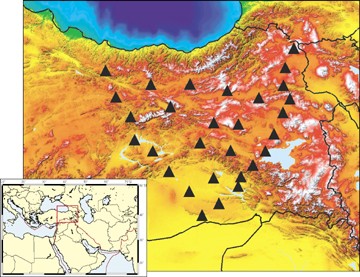
Geotimes Home | AGI Home | Information Services | Geoscience Education | Public Policy | Programs | Publications | Careers

 Researchers
recently published preliminary results of the first data collected with modern
techniques documenting the tectonic and seismic regimes of eastern Turkey. Their
work may overturn conceptions of the tectonic setting of the region.
Researchers
recently published preliminary results of the first data collected with modern
techniques documenting the tectonic and seismic regimes of eastern Turkey. Their
work may overturn conceptions of the tectonic setting of the region. |
Geotimes Home | AGI Home | Information Services | Geoscience Education | Public Policy | Programs | Publications | Careers |